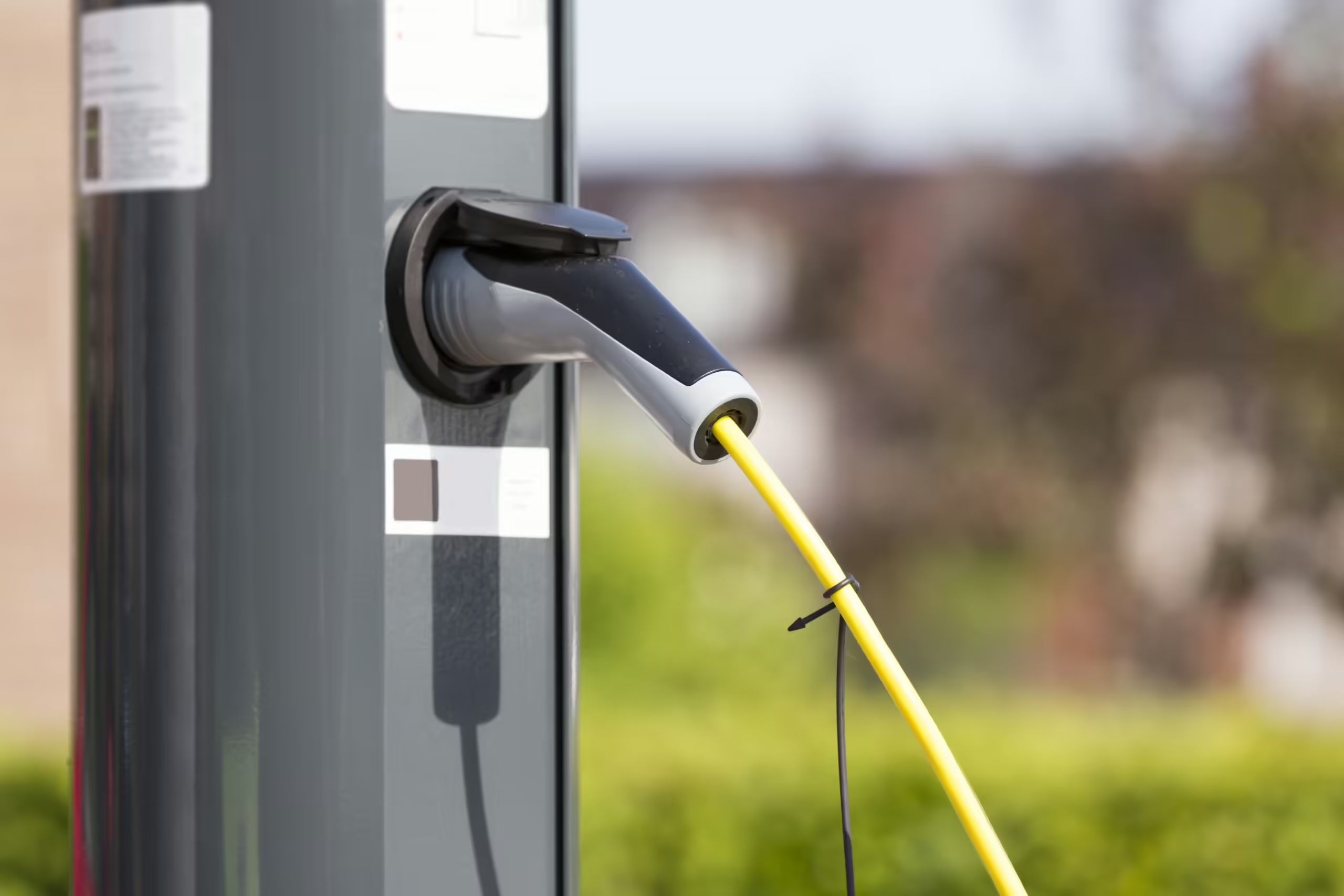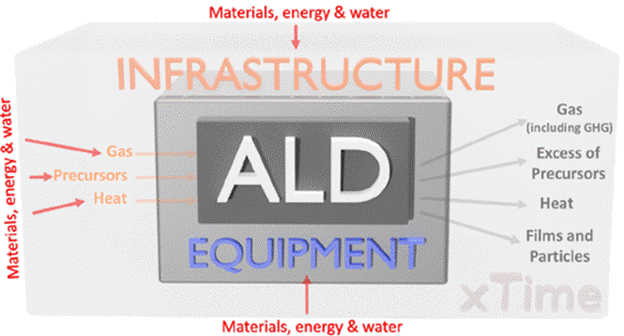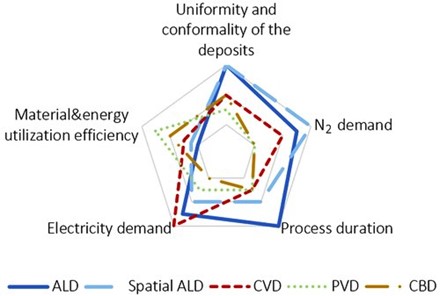Sustainability in ALD and Green ALD Practices
Strategies Towards Greener ALD

Strategies Towards Greener ALD

Atomic layer deposition (ALD) has enabled smaller, faster, and more efficient electronics, and is emerging in industrial production lines outside traditional semiconductor applications. The importance of ALD is unquestioned, but how does it fit into an increasingly environmentally-conscious world? Now that atomic layer deposition has proved its worth, can we make its legacy sustainable? Learn here about the environmental impact of ALD, how it compares to other deposition techniques, and the strategies for making it greener.
Article co-written by Abhishekkumar Thakur from Atomiclayerdeposition.com
Atomic layer deposition (ALD) is a powerful technique for depositing material one atomic layer at a time. Used in various technologies that affect our daily lives, ALD is employed, for instance, in manufacturing advanced electronic chips, like those found in smartphones and PCs.
ALD inherently allows for precise layer-by-layer growth of nanomaterials, thus reducing excess elements and materials in manufacturing. This makes it a potentially environmentally friendly method due to its atomically precise reactions. However, some of the chemical precursors used in ALD and the resulting by-products can be toxic and have negative environmental impacts.
With the size of the global atomic layer deposition market reaching nearly USD 2 billion in 2021, it is increasingly necessary to assess the environmental impacts associated with ALD technology. In this article, let’s explore the current state of sustainability in ALD and potential strategies for a greener future.
Matthieu Weber from Grenoble Alpes University, France, recently published an important article on the topic of ALD’s environmental footprint. In it, he included a summary of studies carried out on the environmental assessment of ALD and relevant Chemical Vapor Deposition (CVD) processes. Some of the important findings are as follows:

It is evident from the noted studies that the slow deposition, low energy and material utilization efficiency of ALD processes contribute to their environmental impact.
When comparing thin-film deposition techniques, wet chemical processes like chemical bath deposition (CBD) or electrodeposition generally require less energy than ALD and chemical vapor deposition (CVD) methods. Nevertheless, ALD and CVD techniques offer unique advantages in terms of the quality and characteristics of the thin films produced, which may lead to fewer environmental impacts.
Deposition techniques like sputtering demand a large energy input, especially in the case of radio frequency (RF) sputtering, which requires high plasma generation power and achieves low deposition rates.
E-beam evaporation is more energy efficient, but the film quality is usually lower. Both sputtering and evaporation have poor conformality and batch deposition properties and are mostly line-of-sight techniques.
In contrast, ALD provides highly conformal deposition even on many substrates at the same time. This batch-scaling potential can significantly reduce environmental impact per deposited area.
Figure 2 presents a comparison between different growth techniques, in terms of material and energy utilization efficiency, electricity and nitrogen demand, process duration, and uniformity and conformality of the deposits. However, it’s important to note that comparing the environmental impact of different manufacturing processes depends on some other specific aspects such as processes, tools, materials and energy type used.

Process and reactor design optimization:
By optimizing the design of the ALD reactor and adjusting processing parameters, it is possible to minimize the consumption of precursors and the release of by-products. The so-called “atom economy” of processes will become important when optimizing their use during ALD experiments.
Additionally, fine-tuning the ALD cycle duration and thermal budget can lead to significant improvements. The dimensions and geometry of the reactor play a crucial role in optimizing gas phase dynamics and surface reaction kinetics, which are essential for efficient ALD. For example, as shown in the figure above, spatial ALD (SALD) performs better than ALD in several aspects.
Thermal management:
Since energy consumption in ALD processes is mainly driven by the operating temperature, efficient thermal management of the heated chamber and heating elements becomes critical. By implementing optimized thermal management strategies, such as insulation and efficient heating, electricity usage can be reduced, resulting in a lower carbon footprint. One such strategy could involve recycling the excess radiative heat as electricity to the system.
Computational modeling:
Computational fluid dynamics (CFD) and Monte Carlo (MC) simulations can be employed to model and design optimized ALD reactors. These simulations help in understanding the gas-phase dynamics and surface reactions, enabling better reactor design and process optimization saving raw materials and resources needed in the initial developmental work.
In-situ measurement techniques and physics-based models:
By employing in-situ measurement techniques and physics-based models, ALD processes can be further optimized. These techniques allow for the measurement of relevant pollutants like greenhouse gases (GHGs), understanding their generation, and finding ways to mitigate emissions.
High throughput processes, such as spatial ALD:
One highly promising approach to reducing the carbon footprint of ALD processes is via high throughput methods, such as spatial ALD. A spatial ALD system, such as the Beneq C2R, offers a promising solution by enabling faster depositions due to its unique mode of operation. As noted, the cycle time is the largest contributing factor to ALD’s environmental footprint. Reducing this with SALD configurations can have a major impact.
One such configuration is the close-proximity atmospheric pressure or open-air variant, where precursors are directly injected onto the substrate without a deposition chamber. This eliminates the energy consumption associated with vacuum and heating systems.
By utilizing these spatial ALD techniques, ALD processes can achieve faster depositions, reduce precursor and energy usage, enable recycling of excess precursors, and simplify the fabrication steps. These improvements contribute to a lower carbon footprint and a more sustainable manufacturing process.
Green Precursors and their synthesis:
The chemical design of precursors plays a crucial role in making ALD processes greener further up the supply chain. A few considerations are important in selecting environmentally friendly precursors for ALD.
Physicochemical Properties: Precursors with high volatility, thermal stability, and reactivity are desirable for successful ALD implementation. Low-temperature deposition precursors are particularly attractive as they reduce the thermal budget required. Considering atom economy is crucial, as reactions with higher atom economies are more efficient, and choosing reaction types that minimize byproduct formation helps minimize the amount of waste generated.
Purity considerations: In some ALD processes, using precursors with slightly reduced purity (e.g., 97% instead of 99.9%) may be sufficient to obtain good quality films. This can limit the need for purification or recrystallization steps. Developing methods for recovering excess precursors, such as condensation steps, can also be beneficial.
Hazardous nature: Assessing the environmental impact of precursor chemistry involves considering the potentially hazardous nature of the precursors. For example, trimethylaluminum (TMA) is a hazardous substance with high pyrophoric and corrosive properties, requiring special care and trained staff. Exploring alternatives such as aluminum alcoholates [Al(OR)3] or aluminum (dimethylamino) propyls [Al(DMP)R] is important.
As a Finnish leader in ALD technology, Beneq Oy has explored conversations regarding the potential environmental impacts of ALD in terms of both ALD equipment production and ALD processes. The Beneq team discusses with experts in the field about how to improve the efficiency of all aspects of ALD, including precursor synthesis.
Listen to an insightful discussion in Episode 7 of the ALD stories podcast, entitled “Green CVD: How sustainable is thin film deposition?”, which features Professor Henrik Pedersen, Professor Seán Berry, and Dr. Jonas Sundqvist.
Assessing the Environmental Impact of Atomic Layer Deposition (ALD) Processes and Pathways to Lower It.M. Weber et. al., ACS Materials Au 2023 3 (4), 274-298, DOI: 10.1021/acsmaterialsau.3c00002
